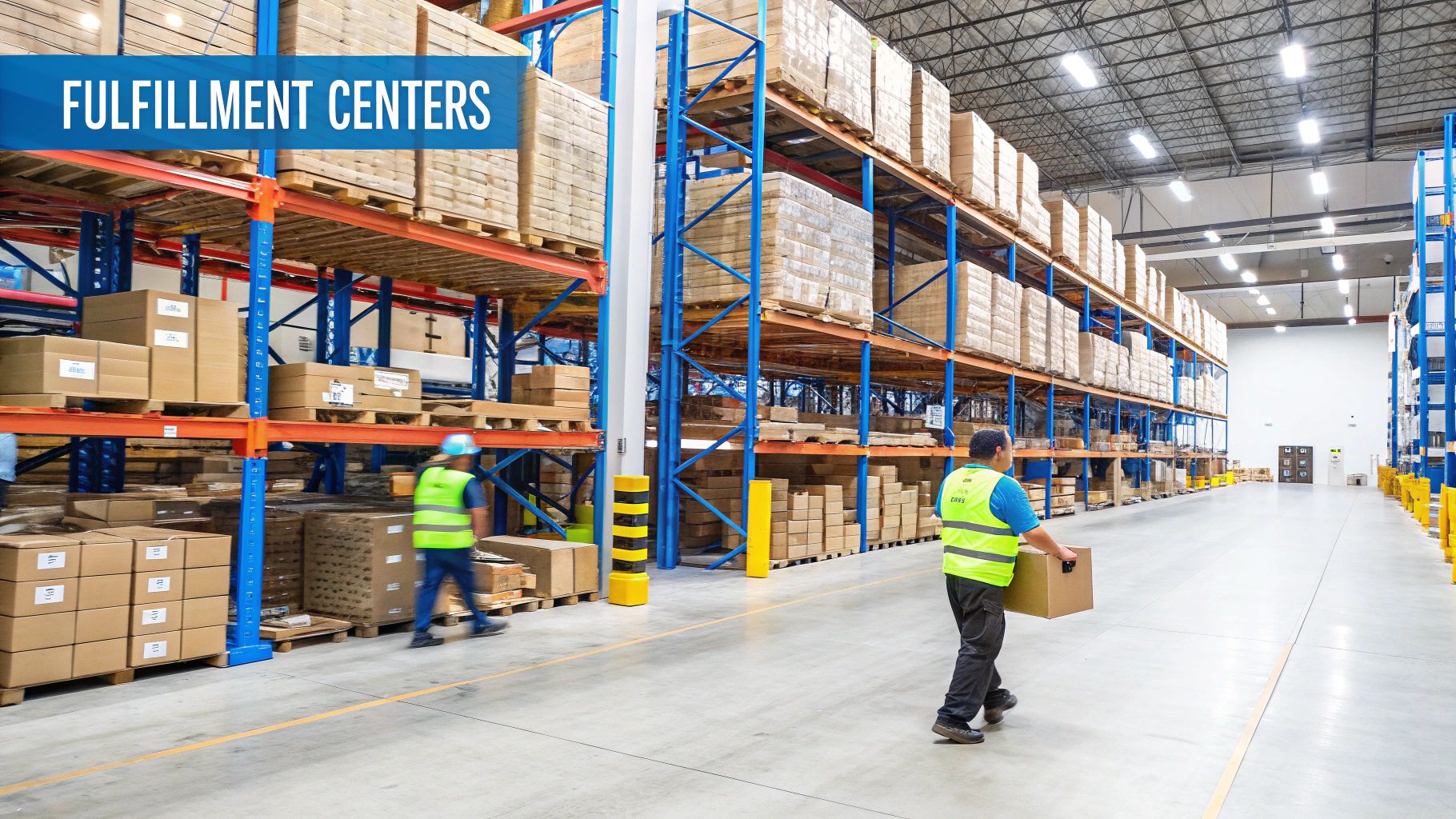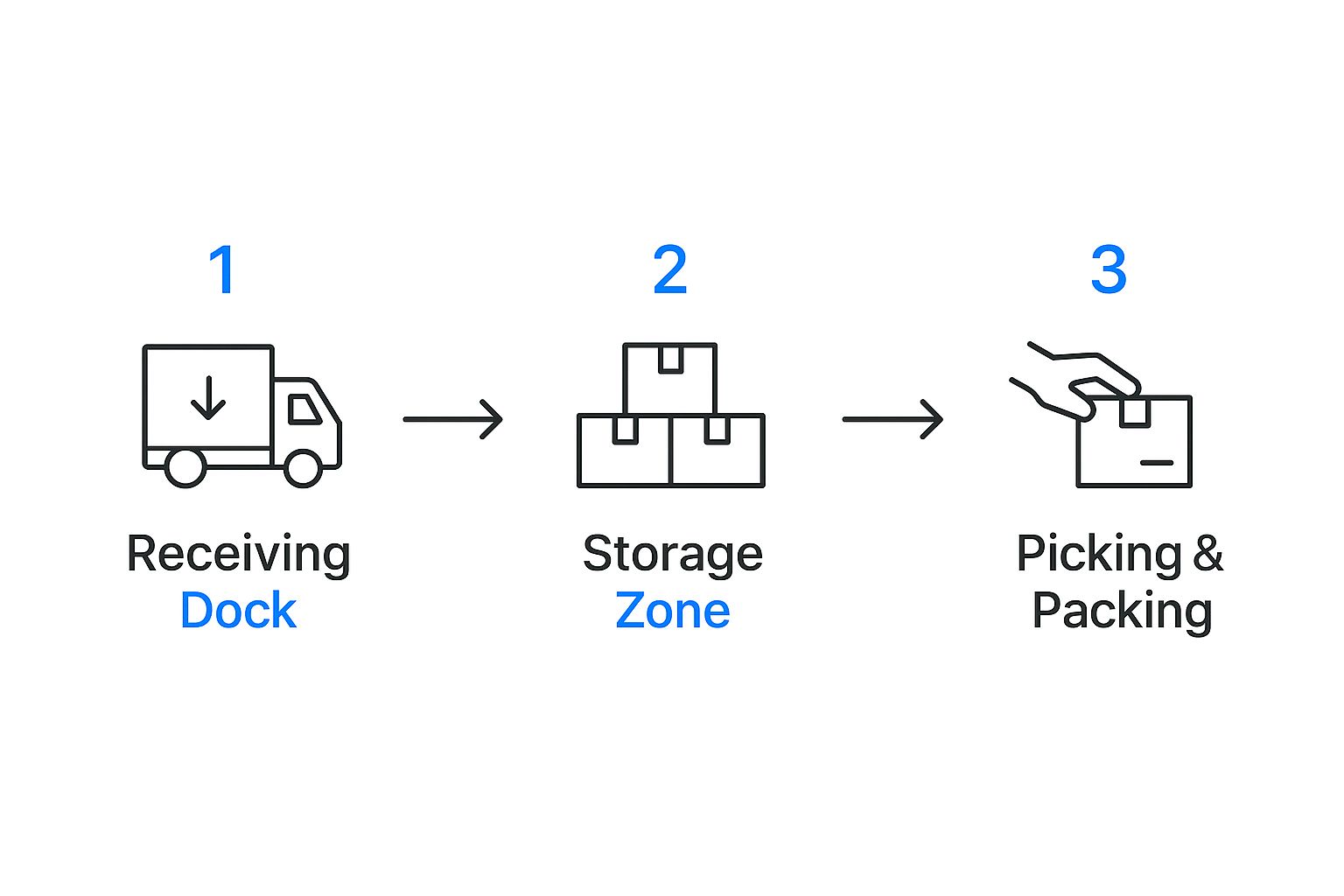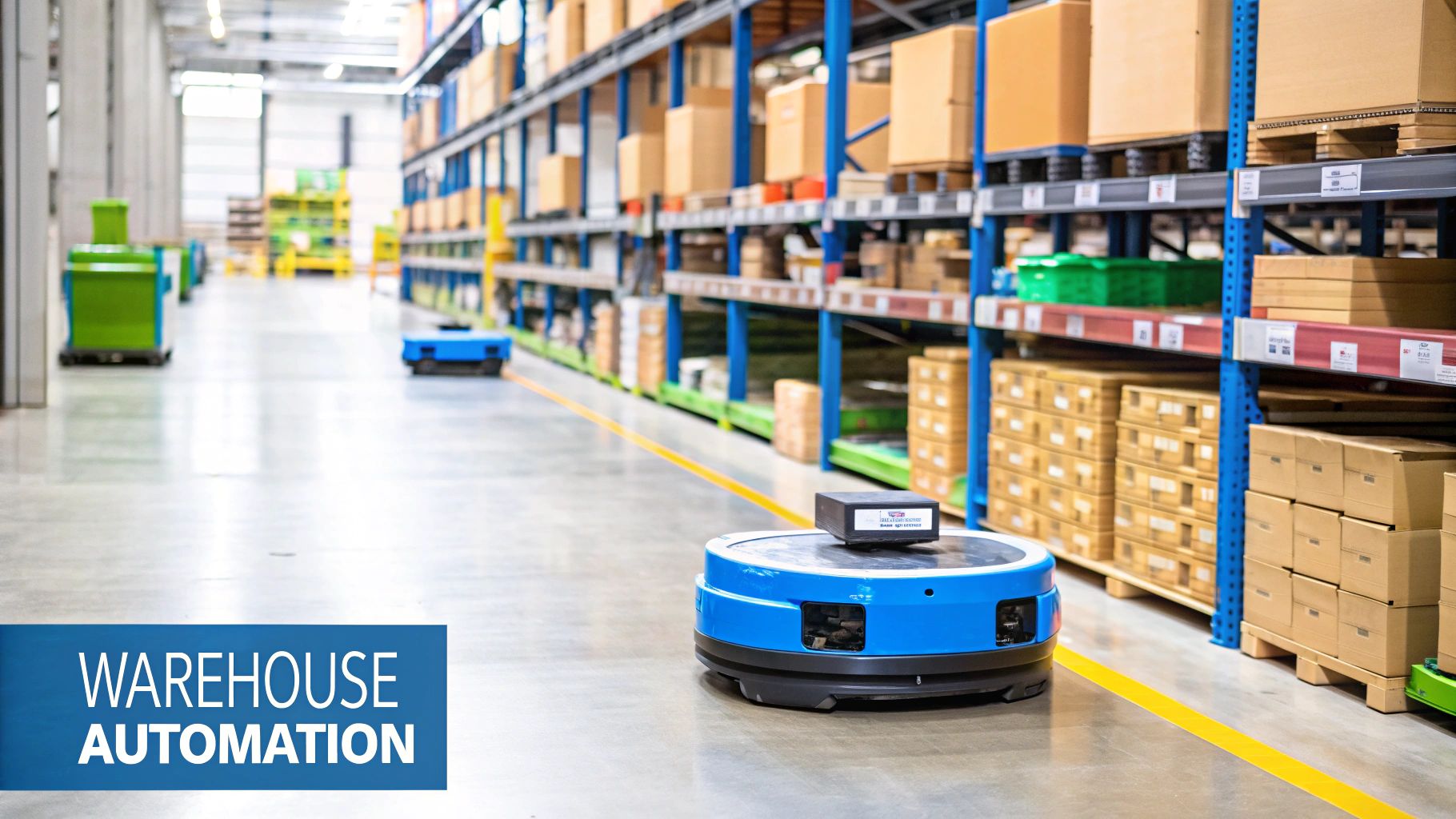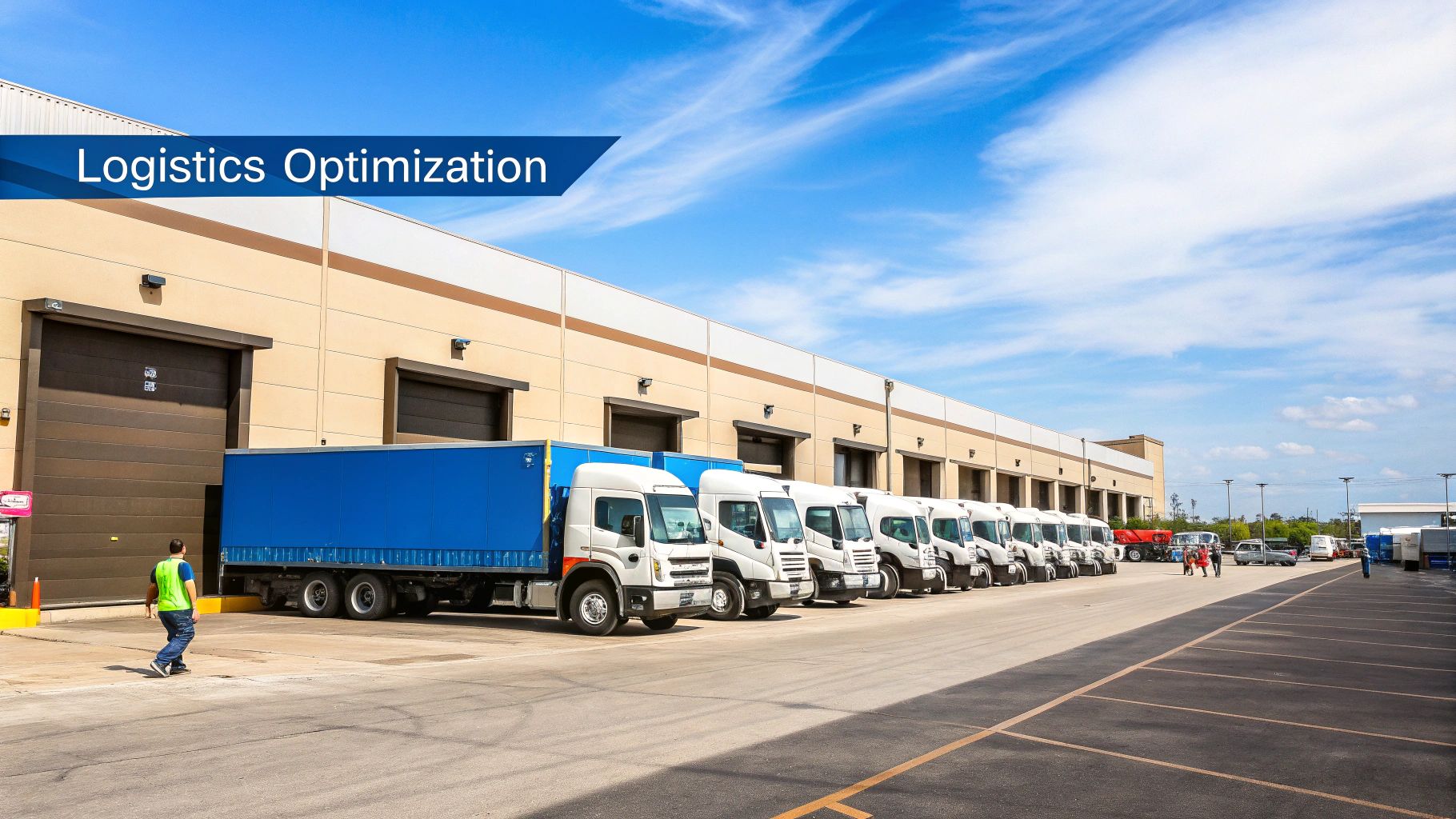Think of fulfillment distribution centers as the command centers for modern ecommerce. They’re highly specialized facilities built not just to store your products, but to actively manage, pick, pack, and ship them directly to your customers with impressive speed and accuracy. This intense focus on high-volume, direct-to-consumer (DTC) shipping is what truly sets them apart.

Imagine your inventory isn't just sitting idle on a shelf, but is instead poised for immediate action the moment an order comes in. That's the entire purpose of a fulfillment distribution center. It’s a world away from a traditional warehouse, which is really just designed for long-term, bulk storage.
A fulfillment center, on the other hand, is built from the ground up for rapid inventory turnover and handling tons of individual orders. The entire layout, the technology, and the team are all geared toward one thing: getting customer orders out the door as fast and flawlessly as possible.
While people sometimes use the terms "fulfillment center" and "distribution center" interchangeably, their jobs are quite different. You can dive deeper into the key differences between a fulfillment center vs a distribution center in our detailed guide, but the easiest way to think about it is movement. Warehouses store, while fulfillment centers move.
To really get a feel for how these places operate, it helps to break down their process into five key functions. Each step is a vital link in the chain connecting your product to your customer's doorstep.
A fulfillment center is a hub of constant activity and complex operations. It is a dynamic environment where technology, processes, and people work in concert to ensure that thousands of individual orders are processed with precision every single day.
This systematic, high-speed approach is exactly what makes fulfillment distribution centers so crucial for growing ecommerce brands. By outsourcing these complex logistics, they free you up to focus on what you do best—developing amazing products, marketing your brand, and building relationships with your customers—instead of getting buried in boxes and packing tape.
That single click on the "Complete Purchase" button doesn't just charge a credit card—it kicks off a highly choreographed dance inside a fulfillment distribution center. This isn't just about grabbing a product off a shelf and slapping a label on it. Modern fulfillment is a sophisticated operation where technology and people work in perfect sync to get orders out the door with incredible speed and accuracy.
The whole process starts the instant your customer's order hits your ecommerce store. That digital "ping" is sent directly to the Warehouse Management System (WMS), which you can think of as the brain of the entire facility. The WMS immediately checks that the items are in stock and then generates a "pick list" for the warehouse team.
This pick list is the starting gun. It's a digital blueprint containing every crucial detail: the specific items (by their SKU), how many are needed, and exactly where they are located within the sprawling warehouse. A warehouse associate gets this list on a handheld scanner, which then maps out the most efficient path through the aisles to collect everything.
To make this process as fast and error-free as possible, fulfillment centers use several smart picking strategies. Common methods include:
This infographic breaks down the fundamental flow of products from the moment they arrive to the second they leave.

As you can see, the physical workflow is a logical sequence designed for maximum efficiency, moving items smoothly from bulk storage to ready-to-ship packages.
Once every item for an order has been picked, it's whisked away—often by conveyor belt—to a dedicated packing station. Here, another team member takes over, selecting the perfect-sized box or mailer. This isn't a random choice; using the right packaging minimizes wasted space, which can reduce shipping costs by up to 20%.
The packer scans each item one last time, a final check to ensure the order is 100% accurate. They then carefully place the products inside, adding any necessary dunnage like bubble wrap or air pillows for protection. This is also where the magic happens for your brand—any marketing inserts, promotional flyers, or custom tissue paper are added to create a memorable unboxing experience.
The packing station is the final quality control checkpoint. It's the last chance to ensure the order is perfect before it's sealed and sent on its way, representing the brand's commitment to excellence directly to the customer.
Finally, the sealed package is weighed, and the WMS automatically prints the correct shipping label based on the customer's chosen delivery speed. The package is placed onto another conveyor, where automated sorters route it to the correct loading bay for pickup by USPS, FedEx, or UPS. From there, it begins the last leg of its journey to the customer's doorstep, with tracking information automatically sent to keep them in the loop. The crazy part? This entire intricate process, from click to carrier, can happen in just a couple of hours.

Handing over your logistics to a specialized partner isn't just about saving a few bucks—it's a massive strategic leap that can unlock serious growth. For direct-to-consumer (DTC) brands, outsourcing to fulfillment distribution centers can turn one of your biggest operational headaches into a genuine competitive edge.
Think about it. Instead of getting bogged down packing boxes and making endless trips to the post office, you can pour that energy back into what actually moves the needle: designing amazing products, crafting killer marketing campaigns, and building real relationships with your customers.
When you hand off the complexities of order fulfillment, you’re not just delegating tasks. You're bringing in a team of experts who live and breathe logistics. This lets you scale your business without the crippling capital investment needed for your own warehouse, staff, and technology.
One of the first things you'll notice after partnering with a fulfillment center is a major drop in your shipping costs. Because these providers ship millions of packages a year, they get access to deeply discounted rates from carriers like USPS, FedEx, and UPS—rates you could never get on your own.
Those bulk discounts get passed directly to you, giving your small or mid-sized brand the kind of shipping prices usually reserved for massive corporations. That extra cash can go straight to your bottom line or allow you to offer more attractive shipping options to your customers.
But it gets better. A great fulfillment partner won't just have one warehouse; they'll operate a whole network of them. By spreading your inventory across multiple fulfillment distribution centers, you can strategically position your products closer to your customers.
This is the secret sauce to unlocking wicked-fast, affordable delivery. When an order ships from a local facility, it can often land on a customer's doorstep in just 1-2 days using standard ground shipping. You get to delight them with speed without breaking the bank on expedited air freight.
Picture this: your brand goes viral overnight, or a Black Friday sale results in a 300% order spike. If you're handling fulfillment yourself, this dream scenario can quickly devolve into a nightmare of shipping delays, backlogs, and a flood of angry customer emails.
Outsourcing gives you the flexibility to handle these swings without breaking a sweat. A fulfillment partner already has the space, staff, and systems in place to manage huge surges in volume. Your business can expand or contract as needed, all while delivering a smooth, consistent experience for your customers.
The global warehousing and storage market is set to hit $869.32 billion by 2025, a clear sign of just how much e-commerce growth relies on sophisticated logistics. This trend underscores the move away from in-house operations toward specialized, scalable infrastructure. You can dive deeper into the global warehousing market and its trends to see where things are headed.
At the end of the day, the biggest win from outsourcing is focus. Let's be honest, running a warehouse is a full-time job that has very little to do with building a brand people love.
By partnering with a third-party logistics (3PL) provider, you instantly gain:
This move empowers you to get back to the high-impact work that truly defines your brand and drives its growth. Choosing the right partner is a make-or-break decision, and our guide on how to choose a 3PL for your business can help you make the perfect choice. For many brands, this is the single decision that allows them to finally compete on a much larger stage.
Peek behind the curtain of any modern fulfillment distribution center, and you won’t just find rows of shelving. You’ll see a powerful technology stack where sophisticated software and hardware work together in perfect harmony. This isn't your grandfather's warehouse filled with clipboards and forklifts. It’s a high-tech ecosystem built for one purpose: to get thousands of orders out the door with incredible speed and pinpoint accuracy.
This tech stack is the real engine driving the operation, turning a complex logistical puzzle into a smooth, efficient process.
At the absolute core of this ecosystem is the Warehouse Management System, or WMS. Think of the WMS as the central nervous system of the entire building. It integrates directly with your ecommerce store, creating a live, seamless connection that gives you real-time data on everything from current inventory levels to the precise status of every order.
The moment a customer clicks "buy," the WMS instantly receives that order, verifies the item is in stock, and generates a pick list for the warehouse team. But this isn't just any list. It's a smart, optimized plan that tells an associate the single most efficient route to walk to gather every item.
A WMS does so much more than just track orders. It’s the command center that manages nearly every function, making sure the physical work happening on the floor aligns perfectly with the digital data from your online store.
Here’s what a modern WMS is really doing:
This digital intelligence is the foundation for everything else that happens, ensuring a smooth, low-error workflow from start to finish.
If the WMS is the brain, then advanced hardware and robotics are the muscle. Today’s top fulfillment distribution centers use a whole range of automated systems to handle the heavy lifting of high-volume ecommerce.
One of the biggest game-changers has been the introduction of Autonomous Mobile Robots (AMRs). Instead of workers walking for miles up and down aisles every day, AMRs bring the shelves directly to the picking stations. This "goods-to-person" approach practically eliminates walking time, which in a traditional warehouse can eat up over 50% of a picker's entire shift.
Automation isn't about replacing people; it's about augmenting their abilities. By letting robots handle the repetitive and physically strenuous tasks, human associates can focus on higher-value activities like quality control, packing, and exceptions handling.
Beyond AMRs, you'll find other critical hardware like high-speed sorting systems that can automatically route thousands of packages per hour to the correct outbound trucks. Smart scales, barcode scanners, and automated dimensioning systems all work in concert to capture data accurately and keep packages flowing without interruption. Once packages leave the warehouse, the process continues; the use of comprehensive fleet management systems is crucial for efficiently dispatching and tracking delivery vehicles on their final journey.
To see this technology working at a massive scale, just look at Amazon. As of April 2025, they run around 1,200 facilities across the globe. One of their flagship centers in California can process up to one million shipments in a single day, a feat made possible with the help of over 7,000 robots. This blend of sophisticated automation and skilled human oversight is what makes modern fulfillment work.
To give you a clearer picture of how these technologies stack up against older methods, let’s compare them side-by-side.
This shift from manual labor to smart automation isn't just about doing things faster. It's about building a more accurate, resilient, and scalable operation from the ground up.
Ultimately, it’s this powerful combination of a smart software brain (WMS) and strong automated hardware that allows modern fulfillment centers to deliver the speed, accuracy, and scalability that today’s DTC brands absolutely need to compete and grow.

The logistics game never stops evolving. Customer expectations for speed, convenience, and eco-consciousness are constantly rising, and the fulfillment distribution centers of tomorrow are racing to keep up with some incredible new tech and strategies.
If you want to stay competitive and keep your customers happy, you need to know what’s coming next. Right now, three huge shifts are changing the game: hyper-local urban fulfillment, a major push for sustainability, and the rise of AI-powered forecasting. Let's break down what these mean for your brand.
Meeting the demand for same-day or even two-hour delivery requires a whole new playbook. Enter the Micro-Fulfillment Center (MFC).
Think of an MFC as a tiny, super-efficient fulfillment hub tucked away in a dense urban area. Instead of shipping from a giant warehouse miles outside the city, MFCs bring your products practically to your customer's doorstep. These small-footprint centers are often set up in the back of existing retail stores or other compact city spaces, drastically cutting down that final delivery distance.
This isn’t just some niche idea—it’s exploding. The global MFC market, valued at $6.2 billion in 2024, is on track to hit an incredible $31.6 billion by 2030. This boom is driven by brands needing to get inventory closer to customers and perfect their last-mile delivery, making MFCs a critical piece of modern logistics.
Today's shoppers want their orders fast, but they also care deeply about the environmental impact. This shift in consumer values is forcing the entire fulfillment industry to go green. Brands that drag their feet on this risk losing customers, especially since over 60% of consumers say sustainability is a key factor in their buying decisions.
This eco-friendly transformation is touching every part of the fulfillment journey:
Sustainable fulfillment isn't just a nice-to-have anymore; it's a business necessity. Weaving green practices into your logistics strategy builds serious brand loyalty and shows you’re committed to more than just the bottom line. It forges a real connection with today's conscious consumer.
Perhaps the biggest leap forward is the use of Artificial Intelligence (AI) and predictive analytics in managing inventory. This tech lets brands shift from being reactive to proactive. Instead of just waiting for orders to come in, you can now accurately predict what your customers will want before they even click "buy."
AI algorithms crunch numbers on historical sales, market trends, seasonality, and even outside factors like holidays or weather events. This gives a fulfillment distribution center the power to forecast demand with stunning accuracy. We dive deeper into last-mile delivery and other key trends in order fulfillment in another one of our articles.
By knowing what's coming, you can strategically place the right products in the right fulfillment centers. This data-first approach means fewer stockouts, lower shipping costs, and faster deliveries for happier customers. Your products will always be exactly where they need to be, ready to go at a moment's notice.
Picking a fulfillment partner is easily one of the biggest decisions you'll make for your ecommerce brand. This isn't just about finding cheap storage for your products; it's about finding a true partner who will directly shape your customer experience, your operational sanity, and your ability to grow.
Think about it: your fulfillment provider is the last team to touch your product before it gets to your customer. Their performance is a direct reflection of your brand. A bad choice leads to a domino effect of shipping delays, damaged products, and angry reviews. But the right choice? That becomes a massive competitive advantage.
A provider's physical footprint is everything. A single, centrally located warehouse might look good on paper, but a distributed network of fulfillment distribution centers is the real secret to faster, cheaper shipping. The goal is simple: get your inventory as close to your customers as possible.
When you're vetting partners, ask them to show you a map of their facilities. Do they have warehouses near major population centers on both coasts? What about the Midwest? This kind of strategic placement is what allows you to offer competitive 2-day shipping to most of the country without paying a fortune for air freight.
Your goal should be to minimize the distance your packages travel. A multi-warehouse strategy not only delights customers with speed but also builds resilience into your supply chain, protecting you from regional disruptions like weather events or carrier delays.
Modern fulfillment is built on a foundation of solid technology. Any partner you consider must have a Warehouse Management System (WMS) that plugs seamlessly into your ecommerce platform, whether that’s Shopify, WooCommerce, or something else. This isn't a "nice-to-have"—it's a non-negotiable.
This connection is what automates the flow of orders from your store to their warehouse floor and gives you real-time visibility into your inventory. Look for a clean, intuitive dashboard that puts you in control of your logistics without making you feel like you need a degree in supply chain management. The tech should make your life easier, not more complicated.
For a more detailed breakdown, our guide on evaluating fulfillment partners for your ecommerce business offers a comprehensive checklist to take with you.
Fulfillment pricing can feel like a maze of different fees for receiving, storage, pick-and-pack, and shipping. Your job is to demand a crystal-clear, transparent pricing sheet. If a provider is cagey about costs for things like kitting, returns processing, or account management, that’s a red flag.
To help you navigate these conversations, we've put together a checklist of key questions to ask any potential partner.
Choosing the right partner requires digging deeper than surface-level promises. Use this table as a guide during your evaluation process to ensure you cover all the critical areas that will impact your business's success.
Asking these specific questions forces potential partners to move beyond generic sales pitches and provide concrete answers about how they operate.
Finally, always look for expertise that matches your product category. Handling apparel is a world away from shipping fragile electronics or temperature-sensitive supplements. A partner with proven experience in your niche already knows the unique storage, packing, and shipping rules your products need. Don't be shy about asking for case studies or references from brands like yours. It's the best way to validate their claims and make a confident decision that will set your brand up for growth.
When you're wading into the world of logistics, a few questions are bound to pop up. Here are some clear, straightforward answers to the things brand owners ask most when they're thinking about partnering with a fulfillment distribution center.
While they're both big buildings that hold inventory, their real jobs are worlds apart. A warehouse is best thought of as a long-term storage locker. It’s built for holding bulk inventory that isn’t going to move very often. The whole operation is pretty static, focused on keeping goods safe and sound.
A fulfillment center, on the other hand, is a beehive of activity. Its entire layout, technology, and workflow are fine-tuned for one purpose: moving inventory out the door fast. It’s an active partner in your business, designed to pick, pack, and ship individual customer orders at lightning speed, making it an absolute must for direct-to-consumer ecommerce brands.
The cost isn't one-size-fits-all, but it’s far more predictable than the mountain of hidden costs that come with doing it yourself. Instead of juggling warehouse rent, staff paychecks, insurance premiums, and a constant stream of packing supply orders, you pay a 3PL for the specific services you actually use.
Typically, the fees you'll see are:
It’s easy to see outsourcing as just another expense, but most brands actually find it saves them money in the long run. You get access to shipping discounts you could never get on your own and completely wipe out the massive overhead of running your own logistics operation.
There’s no magic number on a sales report that tells you it's time, but there are definitely some tell-tale signs. If you're spending more of your day taping up boxes than you are on marketing or creating new products, your own logistics are probably holding back your growth.
Another huge red flag is when you simply can't keep up with orders, especially when a holiday or a big sale hits. If you notice shipping delays are becoming the norm and packing mistakes are creeping in, that's a clear signal you've outgrown the garage. Moving to a fulfillment distribution center is how you get your time back and give your customers the professional experience they expect.
Absolutely. Most modern fulfillment centers manage the entire returns process, often called reverse logistics. When a customer sends something back, the package arrives at the center where it gets opened and inspected by a trained team member.
From there, they follow whatever rules you've set. They'll figure out if the product can be put right back on the shelf, needs to be set aside for a closer look, or should be disposed of. The whole process is tracked in their system, so you always know what’s going on and can get perfectly good products back into your sellable inventory right away.
Ready to stop packing boxes and start scaling your brand? Simpl Fulfillment offers a complete, transparent, and technology-driven solution for your ecommerce business. Get a quote today and see how we can handle the logistics while you focus on growth.